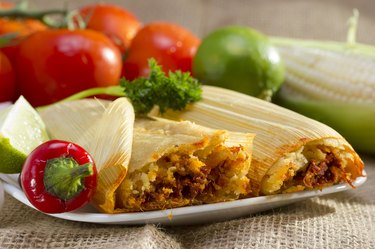
Tamales are a traditional Mexican dish served at New Year's Eve or Christmas Eve dinners, and other special occasions and holidays. Not only are tamales healthy, but some also say they symbolize ideas like wealth, sustenance and family in Mexican and Mexican American cultures, offering both comfort and nutrition to those who enjoy them.
What Are Tamales?
Video of the Day
A tamale, or in Spanish "tamal," is a steamed bundle of corn (masa) dough stuffed with tasty fillings like beef, pork or chicken, cheese and veggies. They originated in Mesoamerica, where Mayan and Aztec farmers grew and revered corn as a sacred food, according to Sam Houston State University.
Video of the Day
Some tamale recipes are high in fat and sodium, but they are also a rich source of vitamins, minerals and fiber that support your health.
Ingredients in Tamales
Some of the most common tamale ingredients include:
- Savory or sweet corn dough
- Lard
- Broth
- Meats, such as beef, chicken or pork
- Fresh or dried fruit (for sweet tamales)
- Veggies
Tamales Nutrition
There's lots of good nutrition in tamales. According to the USDA, one tamale will give you:
- Calories: 300
- Total fat: 18 g
- Saturated fat: 5 g
- Trans fat: 0 g
- Cholesterol: 21 mg
- Sodium: 680 mg
- Total carbs: 28 g
- Dietary fiber: 5 g
- Sugar: 0 g
- Protein: 9 g
Nutritional Benefits of Tamales
Homemade tamales are loaded with health benefits thanks to the ingredients used to make them.
Carbs
Eating one tamale gives you 28 grams of carbohydrates, which your body uses for energy. Of those carbs, some comes from dietary fiber, which comes with its own benefits.
Fiber
Corn masa, and other corn products, are considered whole grains, and whole grains are typically loaded with fiber.
One tamale gives you 5 grams of fiber, a nutrient you need for a healthy gut, brain and heart (just to name a few), according to the Mayo Clinic.
Protein
You'll get a good dose of protein when you eat a tamale, too. One tamale gives you 9 grams of the satiating, muscle-building nutrient, per the USDA.
Vitamins and Minerals
Tamales offer some vitamin A, with one giving you 25 percent of the recommended Daily Value (DV). Vitamin A is needed for healthy teeth, skeletal and soft tissue, mucus membranes, and skin, according to the National Library of Medicine (NLM).
Thanks to the beef, you'll also get a good amount of iron from tamales, with one offering 15 percent of the DV. Iron helps carry oxygen from our lungs to the rest of our bodies and helps our muscles store and use oxygen, per the NLM.
Potential Downsides of Tamales
Tamales are a cultural staple for many, and enjoying them on special occasions, such as Christmas Eve, probably won't do much harm.
That said, eating tamales every day or very often might not be the best idea, especially if you're at a higher risk for heart disease.
Fat
Tamales made with lard are going to be higher in fat than those made with other fat sources, such as butter or corn oil.
Saturated fat should be limited to five or six percent of your total daily calories (which is about 120 calories per day if you eat a 2,000-calorie diet) to keep your heart disease risk factors low, according to the American Heart Association (AHA).
Sodium
Pre-made tamales and those you order at restaurants may be high in sodium, which raises heart disease risk factors, per the AHA. One tamale has 680 milligrams of sodium, which is a rather high 30 percent of the recommended DV.
Limit sodium in your diet to no more than 2,000 milligrams per day, or 1,500 milligrams if you're already at a higher risk for heart disease, per the AHA.
Tips for Healthy Tamales
Instead of purchasing them from a store, preparing homemade tamales can help you control the sodium and fat. This way, you can use any ingredients you like, such as vegetables, chicken or beans to make fillings instead of beef or pork.
Adding beans adds even more satiating, gut-friendly fiber. Replacing the lard traditionally used for making corn dough with part-skim ricotta cheese will help slash the fat and calories in your tamales.
Here's a homemade tamales recipe you can make in the oven.
- Eating Well: Hot Tamales
- USDA National Nutrient Database for Standard Reference: Tamales (Navajo)
- U.S. Food and Drug Administration: Guidance for Industry: A Food Labeling Guide (14. Appendix F: Calculate the Percent Daily Value for the Appropriate Nutrients)
- Helpguide.org: Choosing Healthy Fats
- Centers for Disease Control and Prevention: Carbohydrates
- University of Maryland Medical Center: Fiber
- MedlinePlus: Protein in Diet
- University of Maryland Medical Center: Iron
- University of Maryland Medical Center: Phosphorus
- University of Maryland Medical Center: Sodium in Diet
- USDA MyFoodData: Beef Tamales (El Monterey)
- Mayo Clinic: Fiber: Essential for a Healthy Diet
- National Library of Medicine: Vitamin A
- National Library of Medicine: Iron
- American Heart Association: Saturated Fat
- Sam Houston State University: Iconic Cuisine: Tamales of the Maya
- University of Maryland Medical Center: Vitamin B3 (Niacin)
- University of Maryland Medical Center: Vitamin B6 (Pyridoxine)
- University of Maryland Medical Center: Vitamin B12 (Cobalamin)
- Eating Well: Squash, Black Bean & Goat Cheese Tamales